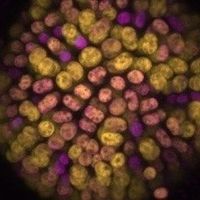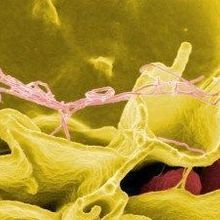Login
Subscribecell & molecular biology, microbiology

Image of the Day: Amoeba Nibbles
Chia-Yi Hou | May 2, 2019 | 1 min read
A pathogenic amoeba species ingests parts of human cells and steals human cell membrane proteins to display on its own surface.

Bacteria Harbor Geometric “Organelles”
Amber Dance | Dec 1, 2018 | 10+ min read
Microbes, traditionally thought to lack organelles, get a metabolic boost from geometric compartments that act as cauldrons for chemical reactions. Bioengineers are eager to harness the compartments for their own purposes.

Infographic: Bacterial Microcompartments Basics
Amber Dance | Dec 1, 2018 | 1 min read
These icosahedral structures are composed of proteins with unique geometric properties, which enable bacteria to employ them in a variety of situations.

Life Thrives Within the Earth’s Crust
Catherine Offord | Oct 1, 2018 | 10+ min read
From journeys into mines to explorations of volcanoes on the ocean floor, deep voyages reveal the richness of the planet’s deep biosphere.

Scientists Can’t Agree on What’s Making Pistachio Trees Sick
Catherine Offord | Aug 1, 2018 | 5 min read
A new study ignites debate on the cause of pistachio bushy top syndrome, a disease that has crippled farms in California, Arizona, and New Mexico.

Image of the Day: Multiple Choice
Sukanya Charuchandra | Jun 19, 2018 | 1 min read
Photosynthesis can happen in more than one way.

Opinion: Constrain Speculation to Protect the Integrity of Science
Mike Klymkowsky | Jun 18, 2018 | 4 min read
What we can know about biology before the last universal common ancestor is limited—and we should be circumspect in filling in the gaps.

Stanley Falkow, Father of Molecular Microbial Pathogenesis, Dies
Catherine Offord | May 9, 2018 | 3 min read
The microbiologist was known for his work on bacterial antibiotic resistance and infectious disease.

Image of the Day: Cell Droplets
The Scientist and The Scientist Staff | Apr 4, 2018 | 1 min read
Proteins and RNA aggregate into “membraneless organelles” due to liquid-liquid phase separation.

Monitoring Mutations with Microfluidics
Ruth Williams | Mar 15, 2018 | 3 min read
A device dubbed the “mother machine” enables real-time observation of mutagenesis in single bacterial cells.

Parasitologist, Reprogrammed: A Profile of David Roos
Anna Azvolinsky | Mar 1, 2018 | 8 min read
After discovering a novel organelle found in protozoan parasites, the University of Pennsylvania’s Roos created a widely used eukaryotic pathogen database.

Researchers Discover 10 New Immune Systems in Bacteria
Jim Daley | Jan 25, 2018 | 3 min read
The findings more than double the number of known defense mechanisms, piquing the interests of molecular biology tool developers.

Neslihan Taş Studies Permafrost Microbes as They’re Roused by a Warming Climate
Shawna Williams | Dec 1, 2017 | 3 min read
The Lawrence Berkeley National Laboratory researcher’s work will help predict how the Arctic is responding to climate change—and the global effects of those changes.

Messing with the Microbiome
Ruth Williams | Jul 16, 2017 | 1 min read
Two new techniques allow researchers to manipulate the activity of gut bacteria.

Zika Grabs Neural Stem Cell Protein to Cause Damage
Jef Akst | Jun 1, 2017 | 2 min read
The new findings, obtained from cell culture experiments, could explain the link between infection with the virus during pregnancy and infant microcephaly.

Inflammation Drives Gut Bacteria Evolution
Ruth Williams | Mar 16, 2017 | 3 min read
Viruses within Salmonella rapidly spread genes throughout the bacterial population during a gut infection, scientists show.

Swarm-Stimulating Bacterial Enzyme Drives Choanoflagellate Mating
Tracy Vence | Dec 8, 2016 | 1 min read
Scientists present evidence of bacteria-driven mating in flagellate eukaryotes at the American Society for Cell Biology annual meeting.

Wanted: Transcriptional Regulators
Ruth Williams | Aug 1, 2016 | 2 min read
Researchers have designed a screen to find unique molecules, called riboswitches, that determine whether transcription will proceed.

Amoebae Have Human-Like Immunity
Jef Akst | Mar 2, 2016 | 2 min read
Dictyostelium discoideum produce extracellular nets that can kill bacteria, just as phagocytes in people and other higher animals do, according to a study.
